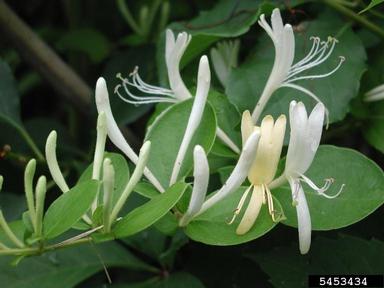Japanese Honeysuckle
Lonicera japonica
Family: Caprifoliaceae
Natural History

Buds and flowers of Japanese honeysuckle
Photo credit: Leslie J. Mehrhoff, University of Connecticut, Bugwood.org
Japanese honeysuckle is a woody vine that can grow up to 120 feet long. This twining vine can either climb up trees, plants, and fences or trail along the ground.
Japanese honeysuckle was introduced to the United States from Japan in the early 1800's as an ornamental plant because of the fragrance of its white to yellow flowers. Since its introduction, Japanese honeysuckle has invaded natural ecosystems where it can spread quickly and completely cover native plants and trees. This growth can shade out and topple these trees and plants killing them. Due to this, Japanese honeysuckle is now listed as a Category I invasive plant by the Florida Exotic Pest Plant Council (FLEPPC).
Japanese honeysuckle occurs in areas that have been disturbed, such as roadsides, yards, and fields; open woodlands, and mature forests. It can survive in both moist and dry habitats. This vine is very common in the southeast and is found from Florida to Texas, north to Kansas, Michigan, Illinois, and east to New England.
Japanese honeysuckle is eaten by deer during the winter months. Deer, small mammals, birds and other wildlife eat the fruit dispersing the seeds.
Japanese honeysuckle has been used as an ornamental plant for gardens. Today, it is still sold in nurseries despite its invasiveness.
